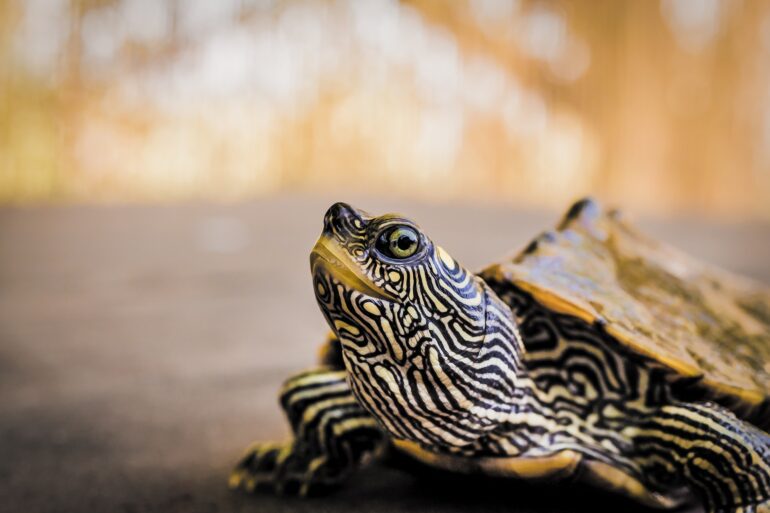Imagine an adventurer, a tiny Indiana Jones with a shell, traversing a lush, sun-dappled jungle. This emerald explorer isn't lost in the Amazon, but gliding through your very own living room aquarium—the magnificent map turtle. With their captivating patterns and inquisitive nature, map turtles captivate turtle enthusiasts with their charm. But before you welcome this intrepid voyager into your aquatic haven, it's crucial to craft a kingdom worthy of their adventurous spirit. Fear not, fellow turtle tamers, for this guide will be your compass, navigating you through the essential steps of creating a thriving map turtle paradise.
Quick Map Turtle Stats
- Size: 5–10 inches (12.5–25 cm)
- Water temperature: 75–80°F (24–27°C)
- pH: 6.5–7.5
- Diet: Omnivorous, enjoys both plant and animal matter
- Tank size: Minimum 75 gallons (284 liters) for a single adult
Habitat Requirements: Optimal Tank Dimensions and Setup
Your map turtle's habitat starts with a spacious tank, a minimum of 75 gallons for a single adult. Remember, these tiny explorers crave the space to roam, bask and dive. Opt for a sturdy glass or acrylic tank and let the landscaping ignite your imagination. Smooth river rocks and pebbles create a natural substrate, while driftwood logs and branches become bridges and hideouts for your turtle's daring escapades. Don't forget the basking platform, a crucial landmass for sunbathing and thermoregulation. Choose a sturdy, textured surface that emerges partially above the waterline, like cork bark or a floating platform.
Dietary Needs: Formulating a Balanced Omnivorous Diet

Peter Paplanus from flickr
Map turtles are omnivorous adventurers, enjoying a diverse diet of both plant and animal matter. High-quality pelleted diets formulated for aquatic turtles should be the staple, supplemented with fresh greens like romaine lettuce, dandelion leaves and bok choy. Don’t forget the protein! Offer your turtle occasional treats like bloodworms, brine shrimp or even small fish to satisfy their inner hunter. Remember, variety is key to a healthy diet, so mix things up and keep your turtle’s taste buds tingling with excitement.
Maintaining the Aquarium: The Importance of Cleanliness
Regular water changes are your first line of defense against murky waters and unhappy turtles. Aim for 20–30% weekly water changes, siphoning the gravel to remove waste and uneaten food. Invest in a reliable filtration system, a canister filter being the ideal choice for larger tanks. Remember, clean water is happy water, and happy water fosters vibrant aquatic explorers.
Beyond the Essentials: Advanced Care and Considerations
- Lighting: Map turtles require both UV light for vitamin D synthesis and basking heat for proper digestion. Install a UVB bulb and heat lamp overhead, ensuring basking temperatures reach 85–90°F (29–32°C).
- Enrichment: Keep your turtle’s mind and body active! Provide floating toys, puzzle feeders and even live plants (choose sturdy varieties like Anubias or Java Fern) to encourage exploration and foraging.
- Companionship: While map turtles can thrive alone, introducing compatible tank mates like goldfish or mollies can add another layer of entertainment and social interaction. Just remember to carefully research tank mate compatibility beforehand.
Embarking on the Adventure: A Shell-ebration of Life
With this guide as your map, you’re now equipped to create a thriving underwater kingdom worthy of your intrepid map turtle explorer. Remember, every turtle is an individual, so observe their behavior, adjust the environment accordingly and don’t hesitate to seek expert advice. Resources like Pets & Animals Tips offer a wealth of information and support to help you navigate the exciting world of turtle care. So, are you ready to set sail on this aquatic adventure and witness the captivating charm of your map turtle unfold in your very own tank?
Map Turtle Q & A:
Can map turtles live outside?
While map turtles can tolerate outdoor ponds in warmer climates, indoor tanks offer more controlled temperature and water quality, making them the ideal, long-term option for most pet owners.
How long do map turtles live?
With proper care, map turtles can live for 20–30 years, becoming lifelong companions on your aquatic adventures.
How much exercise does a map turtle need?
Map turtles are naturally active swimmers and explorers. Providing a spacious tank with room to roam and climb is crucial. Additionally, offering floating toys, bubbles and even live plants (like Elodea) can encourage foraging and playful behavior.
What water testing is important for map turtle care?
Regularly test your aquarium water for pH, ammonia, nitrite and nitrate levels. Maintaining a stable pH between 6.5–7.5 and keeping ammonia and nitrite at 0ppm is essential for your turtle’s health. Nitrate levels should be kept below 20ppm for optimal water quality.
Can I handle my map turtle?
While occasional gentle handling can be tolerated, it’s best to minimize it. Map turtles can become stressed easily and frequent handling can harm their health. Instead, observe their behavior and provide enriching activities within their aquarium to foster a positive relationship.
What do I do about hibernation?
Hibernation is a natural behavior for map turtles. If you live in a colder climate, provide a cool, dry box filled with damp substrate during the winter months. Consult your veterinarian or a knowledgeable reptile specialist for detailed hibernation guidelines.





